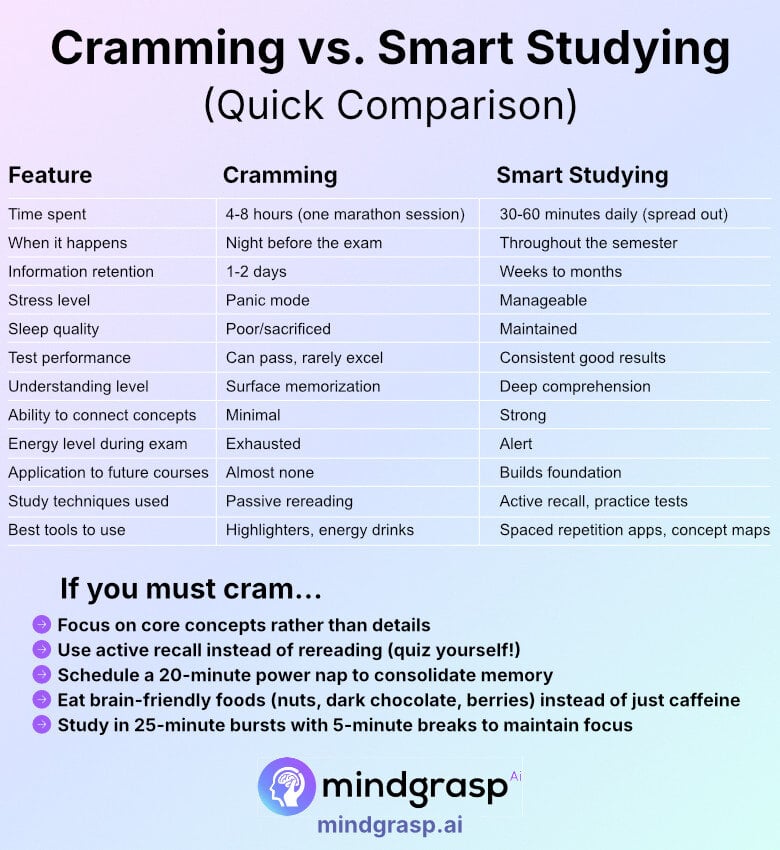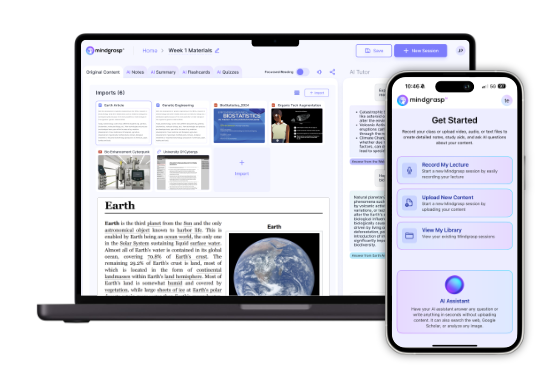
Cramming for an exam? You're not alone.
Sometimes you don’t have the luxury of a perfect study plan — life gets busy, deadlines pile up, and suddenly that test you thought was next week is actually tomorrow. 😬
So if you’re wondering how to cram right now, let’s cut to the chase.
How to Cram for Exams (Fast and easy!)
- Prioritize what actually matters.
Look at your syllabus or lecture notes. Focus on high-weight topics. Don’t try to learn everything — identify the 20% of material that’s likely to be 80% of the test. - Summarize and skim.
Skim textbooks or lecture slides. Summarize each section in your own words. If possible, use an AI summarizer like Mindgrasp to instantly condense large PDFs or chapters. - Use active recall.
Test yourself. Use flashcards or have someone quiz you. Don’t just reread — make your brain work to remember. You’ll retain more in less time. - Create or use practice questions.
Re-do old exams, sample problems, or use tools that generate questions based on your material. - Teach it to yourself (out loud).
Pretend you're explaining a concept to a friend. If you can’t teach it, you don’t understand it — this forces clarity. - Study in intervals.
Use the Pomodoro Technique (25 min study, 5 min break). Don’t grind non-stop — your brain needs space to absorb. - Sleep at least 5–6 hours.
All-nighters feel productive, but your brain needs rest to consolidate memory. Even a few hours helps.
If you need to cram for an exam the night before, Mindgrasp can help you convert your notes, readings, and even YouTube lectures into concise summaries, flashcards, and quizzes. So you spend less time preparing and more time learning.
Study smarter even if it's last minute!
Turn PDFs, lecture slides, and articles into clear summaries, flashcards, and quizzes — no more endless reading.
Try it FreeShould you be cramming for exams at all?
Cramming is a last-resort strategy. It’s like using duct tape to hold your grade together — it can work, but it’s not a long-term solution.
So, should you be cramming? Ideally, no. But if you’re here, there’s a good chance you’re in crunch mode. That’s okay — just know cramming is about short-term recall, not deep understanding.
After this exam, apply these lessons to prepare smarter next time. We'll show you how below.
Why shouldn’t you cram before an exam?
Cramming might get you through tomorrow's test, but it comes at a cost. The biggest issue? What you learn in a cram session often doesn't stick.
Your brain can only absorb so much at once. Under stress, most last-minute information disappears within days or even hours.
You might pass the test but struggle later. The material won't be there when you need it for finals or future classes.
Cramming leads to burnout, poor sleep, and stress. Staying up all night feels productive, but lack of sleep makes remembering harder. Exhaustion and anxiety harm your test performance.
In short: cramming sacrifices real learning. Your future self will thank you for using smarter study habits instead.
What is cramming for a test, exactly?

Cramming is when you try to learn everything right before a test. It’s usually fueled by panic, procrastination, or a packed schedule. Flipping through textbooks at midnight when your exam is the next morning.
Instead of studying over time, you rush through everything in a few hours.
Instead of studying a little each day, cramming squeezes all your studying into one rushed session. You're not trying to truly understand the material—you just want to remember enough to pass tomorrow.
Picture this: energy drinks, highlighted notes everywhere, and the growing fear that you won't finish in time. You're memorizing facts without caring how they connect, just hoping the right information sticks until the test is over.
Cramming is basically an emergency response to not planning ahead. Almost every student does it sometimes, but that doesn't make it a good strategy. It might help you survive one test, but the information rarely stays in your brain for long.
Does cram studying actually work?
Sometimes, yes — cramming can help you recall information for tomorrow's test. But it doesn't stick. You'll likely forget most of what you "learned" right after the exam ends.
Studies show that cramming creates three problems:
- Poor long-term memory
- Weaker critical thinking
- More test anxiety
What science says about cramming
- Short-term memory gains: You might remember things for a few hours, but your brain doesn’t have time to fully process and store it.
- No time for deep learning: Concepts stay shallow — you can recognize answers on a multiple choice test but struggle to apply them later.
- Increased stress: Cramming raises cortisol (stress hormone), which actually makes it harder to recall information.
A better approach? Combine active recall, spaced repetition, and tools like AI note generators throughout the semester to avoid the panic altogether.
Best Way to Cram for an Exam (If You Must)
Here’s how to cram more effectively:
- Make a quick checklist of what you need to know.
- Use summaries to grasp concepts fast (our AI study tool Mindgrasp can save you hours!).
- Focus on understanding the big ideas, not memorizing every detail.
- Use flashcards and self-quizzing to reinforce learning and lock in key information.
- Take short breaks (5-10 minutes) to keep your mind fresh.
- Get some sleep before your exam, seriously! Your brain needs it to remember what you studied.
How to avoid cramming while studying next time (and actually learn more)
Instead of relying on last-minute panic, try this approach going forward:
- Summarize each lecture right after class.
With Mindgrasp, upload your materials and get instant notes, flashcards, and practice questions. - Set small weekly review sessions.
Just 20–30 minutes per subject to review past material. Use active recall. - Use spaced repetition.
Study over time, not all at once. Revisit material in intervals for better memory. - Quiz yourself often.
Even short quizzes dramatically improve retention. - Build a library of past study materials.
Mindgrasp saves your notes, quizzes, and summaries in one place for easy review before exams.

Want to Improve Your GPA (So You Don’t Have to Cram Again)?
If you're cramming right now, we get it — sometimes it's the only option. But if you're tired of last-minute stress and want to get ahead next time, check out our resources below.
We've created guides to help you raise your GPA the smart way. Learn how GPA works, calculate what you need, or follow a simple plan to boost your grades. We've got you covered.
GPA Guide: Everything You Need to Know in Plain English
Confused about how GPA works, what counts, and what doesn’t? Start here.
Step-by-Step Guide: How to Improve Your GPA
Practical tips (with AI tools included) to help you study smarter and raise your GPA faster.
Use Our Free GPA Calculator
Plug in your grades and see exactly what it takes to hit your target GPA.
Use cramming as a lifeline, not a lifestyle
Cramming might help you pass the next test, but real academic success comes from consistent, smarter studying — not just harder studying.
AI-powered learning tools like Mindgrasp give you a huge edge whether you're in panic mode or preparing weeks in advance.
With just a few clicks, you can turn dense materials into digestible notes, quizzes, and flashcards — helping you remember more in less time, and yes… even cram better if you absolutely have to.
Ditch the last-minute panic and download Mindgrasp from the App Store
Turn any textbook, lecture, or video into bite-sized notes, flashcards, and quizzes so you can learn more in less time.
Download the iOS App
